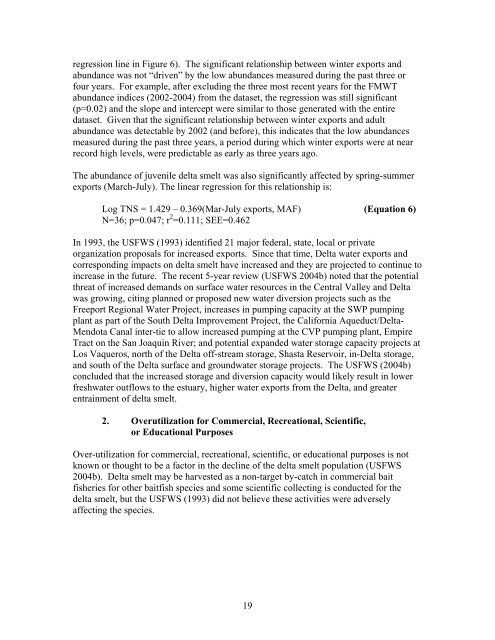ESWR page - Endangered Species & Wetlands Report
ESWR page - Endangered Species & Wetlands Report
ESWR page - Endangered Species & Wetlands Report
You also want an ePaper? Increase the reach of your titles
YUMPU automatically turns print PDFs into web optimized ePapers that Google loves.
egression line in Figure 6). The significant relationship between winter exports and<br />
abundance was not “driven” by the low abundances measured during the past three or<br />
four years. For example, after excluding the three most recent years for the FMWT<br />
abundance indices (2002-2004) from the dataset, the regression was still significant<br />
(p=0.02) and the slope and intercept were similar to those generated with the entire<br />
dataset. Given that the significant relationship between winter exports and adult<br />
abundance was detectable by 2002 (and before), this indicates that the low abundances<br />
measured during the past three years, a period during which winter exports were at near<br />
record high levels, were predictable as early as three years ago.<br />
The abundance of juvenile delta smelt was also significantly affected by spring-summer<br />
exports (March-July). The linear regression for this relationship is:<br />
Log TNS = 1.429 – 0.369(Mar-July exports, MAF) (Equation 6)<br />
N=36; p=0.047; r 2 =0.111; SEE=0.462<br />
In 1993, the USFWS (1993) identified 21 major federal, state, local or private<br />
organization proposals for increased exports. Since that time, Delta water exports and<br />
corresponding impacts on delta smelt have increased and they are projected to continue to<br />
increase in the future. The recent 5-year review (USFWS 2004b) noted that the potential<br />
threat of increased demands on surface water resources in the Central Valley and Delta<br />
was growing, citing planned or proposed new water diversion projects such as the<br />
Freeport Regional Water Project, increases in pumping capacity at the SWP pumping<br />
plant as part of the South Delta Improvement Project, the California Aqueduct/Delta-<br />
Mendota Canal inter-tie to allow increased pumping at the CVP pumping plant, Empire<br />
Tract on the San Joaquin River; and potential expanded water storage capacity projects at<br />
Los Vaqueros, north of the Delta off-stream storage, Shasta Reservoir, in-Delta storage,<br />
and south of the Delta surface and groundwater storage projects. The USFWS (2004b)<br />
concluded that the increased storage and diversion capacity would likely result in lower<br />
freshwater outflows to the estuary, higher water exports from the Delta, and greater<br />
entrainment of delta smelt.<br />
2. Overutilization for Commercial, Recreational, Scientific,<br />
or Educational Purposes<br />
Over-utilization for commercial, recreational, scientific, or educational purposes is not<br />
known or thought to be a factor in the decline of the delta smelt population (USFWS<br />
2004b). Delta smelt may be harvested as a non-target by-catch in commercial bait<br />
fisheries for other baitfish species and some scientific collecting is conducted for the<br />
delta smelt, but the USFWS (1993) did not believe these activities were adversely<br />
affecting the species.<br />
19
















